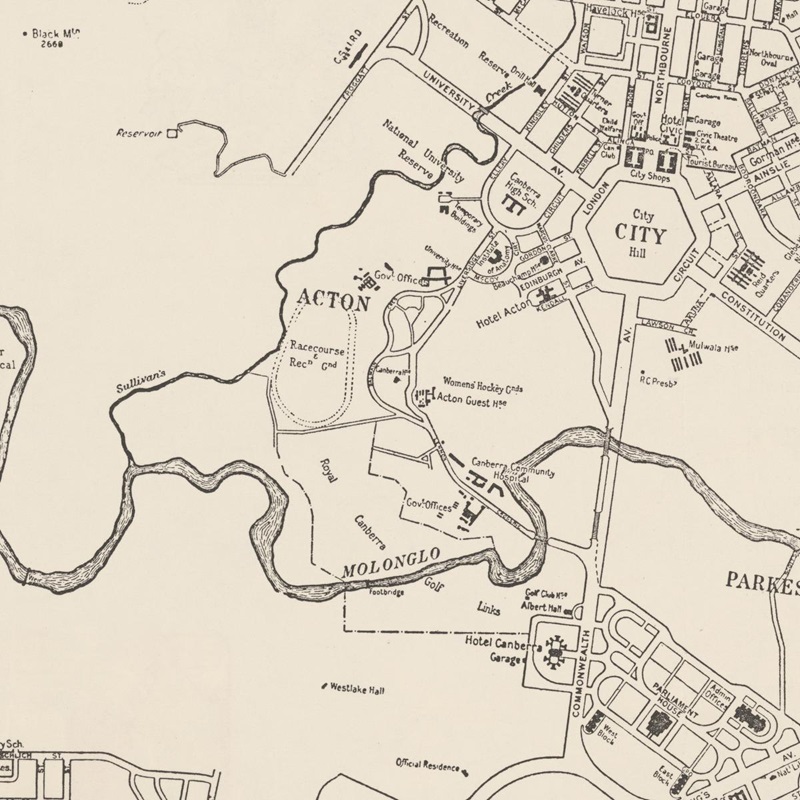Posted 17/10/2022 by Nathan Church
On this day 58 years ago, Prime Minister Robert Menzies formally inaugurated Canberra’s iconic Lake Burley Griffin. The lake’s development was both protracted and contentious, ostensibly as it involved submerging the Royal Canberra Golf Club (RCGC). This Flagpost article recounts the bureaucratic machinations involved in this story, including whether senior officials delayed the lake’s construction to maintain access to the golf course.
Burley Griffin’s plan
Walter Burley Griffin’s winning design for Australia’s national capital (announced in May 1912) included an ornamental lake established from the Molonglo River. However, the financial austerity imposed by the First World War and more pressing priorities led to significant delays. For example, the 1926 Parliamentary Standing Committee on Public Works’ report into the ‘construction of a dam and improvements on the Molonglo River in the Federal Capital’ noted (in para. 14):
Under these circumstances, the whole proposal resolved itself into the expenditure of a sum of approximately £50,000 for the purpose of providing bathing and boating facilities for the inhabitants of Canberra, until such time as it was deemed expedient to proceed with the construction of the full lake scheme as provided in the approved design of the City, and this expenditure the Committee at the present time considers unwarranted.
The Canberra Golf Club was formed the following month on 19 July (with the ‘Royal’ designation subsequently added in 1933). Yet despite the entrenched position of the RCGC and other sporting and recreational fields on the site, during Federation’s half-century Jubilee in 1951 the Government still sought to implement the Lakes Scheme as part of its work schedule. Additionally, following the Second World War the National Capital Planning and Development Committee continued to debate the RCGC’s ongoing site, especially within the context of nearby Westbourne Woods as an alternative location. However, Burley Griffin’s plan was not without its critics, none more so than William McLaren.

Source: Sunken Stories of Old Acton
The impact of William Alexander McLaren
McLaren was appointed as Secretary of the Department of the Interior in 1949. In this capacity he was ‘unenthusiastic about Walter Burley Griffin's plan for the national capital’ and ‘rather like having an atheist in charge of a monastery’ (p. 9). McLaren’s obituary in the Canberra Times recorded him being ‘an active member of the Royal Canberra Golf Club’; however, it is unclear when this association with RCGC commenced. It is also notable that seven months after McLaren became the Department Secretary, the RCGC received no special treatment from the Department of the Interior’s direction to reduce its water consumption by 75% until further notice, due to a mechanical breakdown at the Cotter pumping station.
Varying the Canberra Plan
On 12 May 1953, the Acting Minister of State for the Interior, Philip McBride, authorised removing the proposed West Lake from the Canberra Plan, with the decision formally gazetted on 11 June 1953 (p. 1612). The variation was reported in the Canberra Times the following day:
The variation will make available an additional square mile of land for city development. The new scheme will preserve the Acton racecourse, much of the Royal Canberra golf course, and housing and farms at Acton. A departmental official said yesterday that the elimination of West Lake in its present form would clear the way for further planning.
Member of the Public Works Committee, Senator Justin O’Byrne, was one of the most critical opponents of this and still recalled some 16 years later:
[I]n the wee small hours of the morning the Secretary of the Department of the Interior had put a proposition to the Minister for signature. It altered the Burley Griffin lake scheme because the lake would have flooded the Royal Canberra golf course. The Minister signed what amounted to an alternative to the Burley Griffin lake scheme. It was to be known as the ribbon of water. We thought that this was rather a strange departure from the original Burley Griffin plan ... Not only did we find that the ribbon of water scheme was well established but also that the alternative golf course at Westbourne Woods was overgrown with trees, and had been practically forgotten. I draw the attention of the Senate to the type of thing that can happen in a bureaucracy where, merely as a symbol, the heads of the bureaucracy put something to parliament knowing they have various and devious ways of influencing the parliament to think along the lines that they want it to think.
When questioned by a Senate Select Committee regarding this variation, Secretary McLaren noted that the revised plan would still require the RCGC’s relocation, and that the RCGC had not lobbied for the variation at all.
West Lake plan re-established
In 1957 the National Capital Development Commission (NCDC) was established and, unlike its purely advisor-to-government predecessor committee, had a broad remit ‘to undertake and carry out the planning, development and construction of the City of Canberra as the National Capital of the Commonwealth’. The NCDC was required to work within the constraints of the Canberra Plan, but only had to consult with the Department of the Interior, as opposed to be directed by it.
In its first annual report, the NCDC asserted that ‘adoption of the Lakes Scheme is the critical decision that must be taken before proposals for the City as a whole can take definite shape’ (p. 13). In its second annual report, ‘the Commission recommended to Cabinet early in 1959 that the full development of the Lakes Scheme should proceed’. This was formally approved by the Minister in May, and the decision was gazetted on 26 October 1959. Accordingly the RCGC relocated to its new facilities at Westbourne Woods on 2 November 1962, and has continued in this location to the present day.
Based on the historical record regarding these events, it is apparent that while some golf-related interests may have delayed Lake Burley Griffin’s development (especially in the 1950s), many other factors also had an impact.